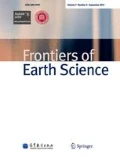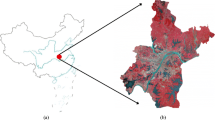Abstract
Lacunarity analysis is frequently used in multiscale and spatial pattern studies. However, the explanation for the lacunarity analysis results is limited mainly at a qualitative description level. In other words, this approach can be used to judge whether the spatial pattern of the objective is regular, random or aggregated in space. The lacunarity analysis, however, cannot afford many quantitative information. Therefore, this study proposed the lacunarity variation index (LVI) to reflect the rates of variation of lacunarity with the resolution. In comparison with lacunarity analysis, the simulated experiments show that the LVI analysis can distinguish the basic spatial pattern of the geography objects more clearly and detect the scale of aggregated data. The experiment showed that different slope types in the Loess Plateau display aggregated patterns, and the characteristic scales of these patterns were detected using the slope pattern in the Loess Plateau as the research data. This study can improve the spatial pattern analysis and scale detecting methods, as well as provide a new method for landscape and vegetation community pattern analyses. Lacunarity analysis is frequently used in multiscale and spatial pattern studies. However, the explanation for the lacunarity analysis results is limited mainly at a qualitative description level. In other words, this approach can be used to judge whether the spatial pattern of the objective is regular, random or aggregated in space. The lacunarity analysis, however, cannot afford many quantitative information. Therefore, this study proposed the lacunarity variation index (LVI) to reflect the rates of variation of lacunarity with the resolution. In comparison with lacunarity analysis, the simulated experiments show that the LVI analysis can distinguish the basic spatial pattern of the geography objects more clearly and detect the scale of aggregated data. The experiment showed that different slope types in the Loess Plateau display aggregated patterns, and the characteristic scales of these patterns were detected using the slope pattern in the Loess Plateau as the research data. This study can improve the spatial pattern analysis and scale detecting methods, as well as provide a new method for landscape and vegetation community pattern analyses.
Similar content being viewed by others
References
Allain C, Cloitre M (1991). Diffraction on Fractals. Scaling Phenomena in Disordered Systems. New York: Springer
Anderson C D, Rosenberg M S (2016). Spatial pattern analysis. In: David Gibson ed, Oxford Bibliographies in Ecology. New York: Oxford University Press
Cao Y Z (1983). Slope features and soil erosion on the loess region. Geogr Res, 2(3): 19–28 (in Chinese)
Dale M R T, Mah M (1998). The use of wavelets for spatial pattern analysis in ecology. J Veg Sci, 9(6): 805–814
Dale M R T (2000). Lacunarity analysis of spatial pattern: a comparison. Landsc Ecol, 15(5): 467–478
Dale M R T, Gibson D J (2002). Spatial pattern analysis in plant ecology. Q Rev Biol, 15(1): 195–196
Dale M R T, Dixon P, Fortin M J, Legendre P, Myers D E, Rosenberg M S (2002). Conceptual and mathematical relationships among methods for spatial analysis. Ecography, 25(5): 558–577
Dikau R, Brabb E E, Mark R M. (1991). Landform classification of New Mexico by computer. Open-File Report.
Dougherty G, Henebry G M (2002). Lacunarity analysis of spatial pattern in CT images of vertebral trabecular bone for assessing osteoporosis. Med Eng Phys, 24(2): 129–138
Drăguţ L, Blaschke T (2006). Automated classification of landform elements using object-based image analysis. Geomorphology, 81(3–4): 330–344
Falcon-Lang H J (2003). Late carboniferous tropical dryland vegetation in an alluvial-plain setting, joggins, Nova Scotia, Canada. Palaios, 18(3): 197–211
Gao Y, Alexander E C Jr, Barnes R J (2005). Karst database implementation in minnesota: analysis of sinkhole distribution. Environmental Geology, 47(8): 1083–1098
Gefen Y, Meir Y, Mandelbrot B B, Aharony A (1983). Geometric implementation of hypercubic lattices with noninteger dimensionality by use of low lacunarity fractal lattices. Phys Rev Lett, 50(3): 145–148
Gefen Y, Aharony A, Mandelbrot B B. (1984). Phase transitions on fractals. iii. infinitely ramified lattices. Journal of Physics A General Physics, 17(6): 1277–1289
Greig-Smith P (1979). Pattern in vegetation. J Ecol, 67(3): 755–779
Hammond E H (2005). Analysis of properties in land form geography: an application to broad-scale land form mapping. Ann Assoc Am Geogr, 54(1): 11–19
Heltshe J F, Ritchey T A (1984). Spatial pattern detection using quadrat samples. Biometrics, 40(4): 877–885
Heupel M R, Simpfendorfer C A (2005). Quantitative analysis of aggregation behavior in juvenile blacktip sharks. Marine Biology (Berlin), 147(5): 1239–1249
Huang X L, Ding H, Na J M, Tang G A (2017). Theories and methods of space-for-time substitution in geomorphology. Acta Geogr Sin, 72(1): 94–104
Keersmaecker M L D, Frankhauser P, Thomas I (2003). Using fractal dimensions for characterizing intra-urban diversity: the example of Brussels. Geogr Anal, 35(4): 310–328
Kristensen L, Olsen J, Weiner J, Griepentrog H W. (2006). Describing the spatial pattern of crop plants with special reference to crop-weed competition studies. Field Crops Research, 96(2–3): 0–215
Larsen D R, Bliss L C (1998). An analysis of structure of tree seedling populations on a lahar. Landsc Ecol, 13(5): 307–323
Li F Y (2010). DEM and image-based loess slope segmentation. In: 3rd International Congress on Image and Signal Processing
Li S J, Xiong L Y, Tang G A, Strobl J (2020). Deep learning-based approach for landform classification from integrated data sources of digital elevation model and imagery. Geomorphology, 354: 107045
Lin B, Yang Z R (1986). A suggested lacunarity expression for sierpinski carpets. J Phys Math Gen, 19(2): 49–52
Mandelbrot B B, Wheeler J A (1983). The fractal geometry of nature. Am J Phys, 51(3): 286–287
McGarigal K (2016). Concepts of scale. In: Landscape ecology course notes. Amherst: Massachusetts University
McIntyre N E, Wiens J A (2000). A novel use of the lacunarity index to discern landscape function. Landsc Ecol, 15(4): 313–321
Oliver M A, Webster R (1986). Semi-variograms for modelling the spatial pattern of landform and soil properties. Earth Surf Process Landf, 11(5): 491–504
Perry J N, Liebhold A M, Rosenberg M S, Dungan J, Miriti M, Jakomulska A, Citron-Pousty S (2002). Illustrations and guidelines for selecting statistical methods for quantifying spatial pattern in ecological data. Ecography, 25(5): 578–600
Plante M, Lowell K, Potvin F, Boots B, Fortin M J (2004). Studying deer habitat on Anticosti Island, Quebec: relating animal occurrences and forest map information. Ecol Modell, 174(4): 387–399
Plotnick R E (1996). The ecological play and the geological theater. Palaios, 11(3): 207–208
Reiji K, Naru T (2014). Climate of the Loess Plateau. In: Restoration and Development of the Degraded Loess Plateau, China, 22–33
Sadahiro Y (2005). Spatiotemporal analysis of the distribution of urban facilities in terms of accessibility. Pap Reg Sci, 84(1): 61
Saunders S C, Chen J, Drummer T D, Gustafson E J, Brosofske K D (2005). Identifying scales of pattern in ecological data: a comparison of lacunarity, spectral and wavelet analyses. Ecol Complex, 2(1): 87–105
Shaw D C, Chen J, Freeman E A, Braun D M (2005). Spatial and population characteristics of dwarf mistletoe infected trees in an old-growth douglas-fir/western hemlock forest. Revue Canadienne De Recherche Forestière, 35(4): 990–1001
Tang G A, Li F Y, Liu X J, Long Y, Yang X (2008). Research on the slope spectrum of the Loess Plateau. Science in China Series E: Technological Sciences, 51(S1): 175–185
Tarolli P, Sofia G (2016). Human topographic signatures and derived geomorphic processes across landscapes. Geomorphology, 255: 140–161
Urban D L, O’Neill R V, Shugart H H Jr (1987). A hierarchical perspective can help scientists understand spatial patterns. Bioscience, 1987(37): 119–127
Williams E A, Wentz E A (2008). Pattern analysis based on type, orientation, size, and shape. Geogr Anal, 40(2): 97–122
With K A, King A W (1999). Dispersal success on fractal landscapes: a consequence of lacunarity thresholds. Landsc Ecol, 14(1): 73–82
Wu H, Li Z L (2009). Scale issues in remote sensing: a review on analysis, processing and modeling. Sensors (Basel), 9(3): 1768–1793
Wu J, Jones K B, Li H, Loucks O L (2006). Scaling and Uncertainty Analysis in Ecology II Concepts of Scale and Scaling. Amsterdam: Springer
Zhao M W, Li F Y, Tang G A (2012). Optimal scale selection for DEM based slope segmentation in the Loess Plateau. Int J Geosci, 1(3): 37–43
Zhou Y, Tang G A, Yang X, Xiao C C, Zhang Y, Luo M L (2010). Positive and negative terrains on northern Shaanxi Loess Plateau. J Geogr Sci, 20(1): 64–76
Acknowledgements
We are grateful for the financial support from the National Natural Science Foundation of China (Grant Nos. 41930102, 41571383, 41771415, 41801321, and 41701450). We sincerely appreciate the editor’s encouragement. The constructive criticisms and suggestions from anonymous reviewers are also gratefully acknowledged.
Author information
Authors and Affiliations
Corresponding author
Rights and permissions
About this article
Cite this article
Dai, Z., Li, F., Zhao, M. et al. Extraction of lacunarity variation index for revealing the slope pattern in the Loess Plateau of China. Front. Earth Sci. 15, 94–105 (2021). https://doi.org/10.1007/s11707-020-0830-4
Received:
Accepted:
Published:
Issue Date:
DOI: https://doi.org/10.1007/s11707-020-0830-4




